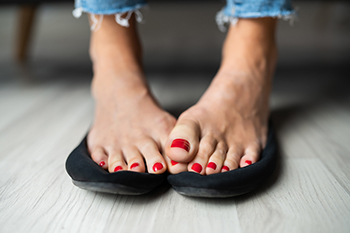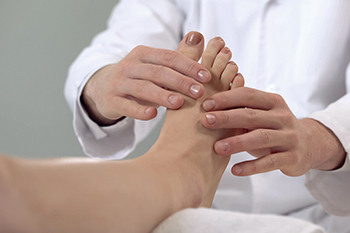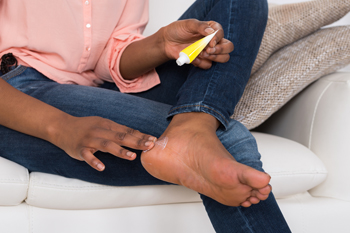September 2022

Most people feel warmed up after exercising, but sometimes it can give you cold feet. A look at the symptoms and causes may help to identify the problem. Symptoms include numbness, tingling, and sensitivity to touch. Causes include compressed nerves, socks or footwear that cuts off the circulation to the feet and toes, and trauma from colliding with a hard object. In addition, cold feet may be the result of fractures, bone spurs, joint swelling, and cysts. Treatment can begin with checking footwear, including both shoes and socks, to see if they are somehow affecting your feet. It’s also a good idea to improve arch support, which takes the pressure off the bottom of your feet. A third option is to vary the types of exercises you do to include less stressful ones that give your feet a rest. It is wise to consult a podiatrist if the sensation of cold feet after exercise continues or becomes worse. It might be an indication of a more serious condition, such as peripheral artery disease. After an examination and diagnosis, a podiatrist can offer treatment options, including medication, custom orthotics, and guidance on appropriate footwear for your situation.
Exercising your feet regularly with the proper foot wear is a great way to prevent injuries and build strength. If you have any concerns about your feet, contact Terri Quebedeaux, DPM from Agave Podiatry . Our doctor can provide the care you need to keep you pain-free and on your feet.
Exercise for Your Feet
Exercise for your feet can help you gain strength, mobility and flexibility in your feet. They say that strengthening your feet can be just as rewarding as strengthening another part of the body. Your feet are very important, and we often forget about them in our daily tasks. But it is because of our feet that are we able to get going and do what we need to. For those of us fortunate enough to not have any foot problems, it is an important gesture to take care of them to ensure good health in the long run.
Some foot health exercises can include ankle pumps, tip-toeing, toe rises, lifting off the floor doing reps and sets, and flexing the toes. It is best to speak with Our doctor to determine an appropriate regimen for your needs. Everyone’s needs and bodies are different, and the activities required to maintain strength in the feet vary from individual to individual.
Once you get into a routine of doing regular exercise, you may notice a difference in your feet and how strong they may become.
If you have any questions please feel free to contact our offices located in Seguin, LaVernia, Gonzales, and Lockhart, TX . We offer the newest diagnostic and treatment technologies for all your foot and ankle needs.

Plantar fasciitis is an extremely common foot affliction that affects a wide variety of different individuals of different backgrounds. Plantar fasciitis is the inflammation of the plantar fascia, the tissue that runs through the arch of the foot. The plantar fascia can become swollen or inflamed when it is strained and overused. There are several risk factors of plantar fasciitis to be aware of that could increase the probability of developing this condition. For example, consistently wearing ill-fitting shoes, or footwear that offers little or no arch support, can increase your risk of plantar fasciitis. Additionally, if you are overweight or have gained a significant amount of weight in a short amount of time, this extra weight that you are putting on your feet could make the development of plantar fasciitis more likely. Lastly, running substantially long distances, particularly on uneven surfaces, can make one more susceptible to plantar fasciitis. Contact a podiatrist today for an appointment if you think that you have plantar fasciitis.
Plantar fasciitis can be very painful and inconvenient. If you are experiencing heel pain or symptoms of plantar fasciitis, contact Terri Quebedeaux, DPM from Agave Podiatry . Our doctor can provide the care you need to keep you pain-free and on your feet.
What Is Plantar Fasciitis?
Plantar fasciitis is the inflammation of the thick band of tissue that runs along the bottom of your foot, known as the plantar fascia, and causes mild to severe heel pain.
What Causes Plantar Fasciitis?
- Excessive running
- Non-supportive shoes
- Overpronation
- Repeated stretching and tearing of the plantar fascia
How Can It Be Treated?
- Conservative measures – anti-inflammatories, ice packs, stretching exercises, physical therapy, orthotic devices
- Shockwave therapy – sound waves are sent to the affected area to facilitate healing and are usually used for chronic cases of plantar fasciitis
- Surgery – usually only used as a last resort when all else fails. The plantar fascia can be surgically detached from the heel
While very treatable, plantar fasciitis is definitely not something that should be ignored. Especially in severe cases, speaking to your doctor right away is highly recommended to avoid complications and severe heel pain. Your podiatrist can work with you to provide the appropriate treatment options tailored to your condition.
If you have any questions please feel free to contact our offices located in Seguin, LaVernia, Gonzales, and Lockhart, TX . We offer the newest diagnostic and treatment technologies for all your foot and ankle needs.

Toenail fungus is a common condition among people of all age groups that can be quite unsightly. The noticeable symptoms include nails that are thickened, yellow, and brittle. If treatment is not promptly sought, the nails may begin to crumble and can eventually fall off. Toenail fungus is caused by a virus and is found in warm and moist environments. These can include public swimming pools, shower room floors, and locker rooms. The fungus can enter the body through small cracks in the skin of the feet and lodge beneath the nail bed. It can be helpful to wear appropriate shoes like flip-flops or water shoes while in these types of areas. Many people are self-conscious about their toes if they are afflicted with toenail fungus. If you have this condition, please speak with a podiatrist who can guide you toward one of several effective treatment options that are right for you.
If left untreated, toenail fungus may spread to other toenails, skin, or even fingernails. If you suspect you have toenail fungus it is important to seek treatment right away. For more information about treatment, contact Terri Quebedeaux, DPM of Agave Podiatry . Our doctor can provide the care you need to keep you pain-free and on your feet.
Symptoms
- Warped or oddly shaped nails
- Yellowish nails
- Loose/separated nail
- Buildup of bits and pieces of nail fragments under the nail
- Brittle, broken, thickened nail
Treatment
If self-care strategies and over-the-counter medications does not help your fungus, your podiatrist may give you a prescription drug instead. Even if you find relief from your toenail fungus symptoms, you may experience a repeat infection in the future.
Prevention
In order to prevent getting toenail fungus in the future, you should always make sure to wash your feet with soap and water. After washing, it is important to dry your feet thoroughly especially in between the toes. When trimming your toenails, be sure to trim straight across instead of in a rounded shape. It is crucial not to cover up discolored nails with nail polish because that will prevent your nail from being able to “breathe”.
In some cases, surgical procedure may be needed to remove the toenail fungus. Consult with your podiatrist about the best treatment options for your case of toenail fungus.
If you have any questions, please feel free to contact our offices located in Seguin, LaVernia, Gonzales, and Lockhart, TX . We offer the newest diagnostic and treatment technologies for all your foot care needs.

Cracked heels, or heel fissures, can look quite unattractive and can feel uncomfortable. This condition can affect a wide variety of individuals and it occurs when the skin on the back of the heels becomes so incredibly dry that the skin breaks or cracks. There are several steps that you might consider taking to prevent the onset of cracked heels. For example, you may try to keep your bare feet from being exposed to extreme hot or cold weather by covering your feet with appropriate dry socks and footwear. Additionally, to try to prevent cracked heels, one could be diligent about checking the ingredients in the soap used to clean one’s body, as soap can often dry out the skin. For instance, sodium lauryl sulfate and artificial fragrances are two main ingredients often used in soap products that can sometimes dry the skin out. Lastly, one could consider not using extremely hot water when taking a bath or shower. If you have heel fissures or are concerned about developing this condition, contact a podiatrist who can help you with this affliction.
Cracked heels are unsightly and can cause further damage to your shoes and feet. If you have any concerns, contact Terri Quebedeaux, DPM from Agave Podiatry . Our doctor can provide the care you need to keep you pain-free and on your feet.
Cracked Heels
Cracked heels appear unappealing and can make it harder for you walk around in sandals. Aside from looking unpleasant, cracked heels can also tear stockings, socks, and wear out your shoes. There are several methods to help restore a cracked heel and prevent further damage.
How Do You Get Them?
Dry skin is the number one culprit in creating cracked heels. Many athletes, walkers, joggers, and even swimmers suffer from cracked heels. Age and skin oil production play a role to getting cracked heels as well.
Promote Healing
Over the counter medicines can help, especially for those that need instant relief or who suffer from chronic dry feet.
Wear Socks – Wearing socks with medicated creams helps lock in moisture.
Moisturizers – Applying both day and night will help alleviate dryness which causes cracking.
Pumice Stones – These exfoliate and remove dead skin, which allows for smoother moisturizer application and better absorption into the skin.
Change in Diet
Eating healthy with a well-balanced diet will give the skin a fresh and radiant look. Your body responds to the kinds of food you ingest. Omega-3 fatty acids and zinc supplements can also revitalize skin tissue.
Most importantly, seek professional help if unsure how to proceed in treating cracked heels. A podiatrist will help you with any questions or information needed.
If you have any questions, please feel free to contact our offices located in Seguin, LaVernia, Gonzales, and Lockhart, TX . We offer the newest diagnostic and treatment technologies for all your foot care needs.

